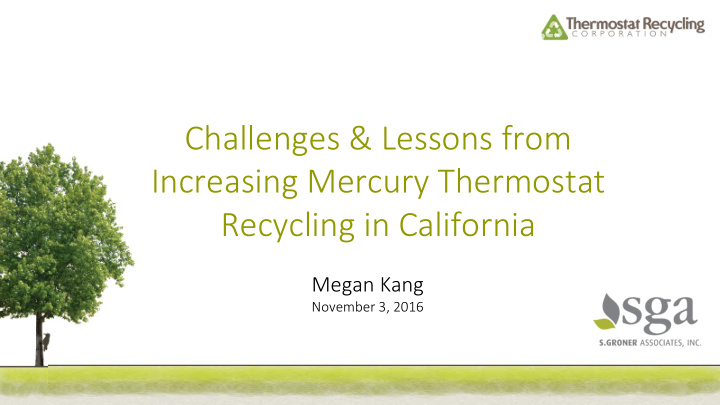



Challenges & Lessons from Increasing Mercury Thermostat Recycling in California Megan Kang November 3, 2016
Outline Mercury Thermostats Collection 1. Background on Mercury Thermostats 2. Challenges of Meeting Collection Requirements 3. State Outreach Program and Pilot Programs 4. Opportunities for HHW Involvement
Mercury Thermostats Background
Facts About Mercury Poses a severe health & environmental threat 200,000-460,000 infants are born into US each year with mercury levels associated with the loss of IQ Fish ingestion is the primary exposure route for most Americans Toxic via inhalation
Hazardous Safe
Mercury thermostats contain 1,000x more mercury than a CFL bulb
Manufacturer use of mercury in thermostats declined from 12,000kg annually to zero in less than six years
Challenges Meeting Collection Requirements
Thermostat Recycling Corporation (TRC)
Challenges of Developing a Statewide Program California Collection rates have declined steadily since 2013 Unique landscape: large and diverse Many target audiences Providing cost-effective, sustained support
Two-Pronged Program 1. Create a comprehensive statewide outreach program for 14 target audiences 2. Develop localized, concentrated pilot efforts
Outreach Plan Framework Connecting with our target audiences
Program Objectives 1. Meet the requirements and deadlines of the Consent Order 2. Increase collection of mercury thermostats 3. Increase collection sites 4. Report what works
Thermostats Collected by Location Type 2015 • 18,260 co collect cted l last y year • Wholesalers (89%) • HHWs facilities (6%) • Contractors (5%) • Retailers (0.01%)
Phased Approach 2016 2017 | October | November | December | January | February | March | April | May | June | July | August | • Multi-family • HVAC contractors • Utility Companies • Commercial • School Districts • General contractors • Hotel/motel • University and colleges • Demolition contractors • Local building • Consumers departments • HHW programs • Retail • Wholesalers
Pilot Project Framework Testing ideas to make a bigger impact
Pilot Program Objective 1. Assess effectiveness of mo monetar ary and nonmon onetar ary incentives to increase program participants and overall collection rates. 2. Provide data-based findings to enhance TRC’s ongoing outreach efforts throughout the state.
Monetary Incentives • Target three locations • Northern CA • Central CA • Southern CA • Incentives • Retailers (immediate) • HHW & Wholesalers (delayed)
Retail In-Store Credit Pilot • One Year, 9 Ace Hardware Stores • Test st: $5, $10 in-store credit • Levels of staff support (trainings, follow up calls/visits) • Vary types of community outreach & messaging • Pilot ot D Design gn: Based on Vermont Pilot Program, 2007
HHW Mail-in-Rebate Pilot • One year, 3 HHW Facilities • Test st: $10/mercury thermostat mail-in-rebate • Pilot ot D Design gn: New pilot to increase HHW participation
Wholesaler Bin Return Pilot • One year, 3 Wholesaler Branches • Test st: $100 mail-in rebate/bin returned • For bins with less than 40 thermostats, pro-rated at $2.50 each • Pilot ot D Design gn: Increase bin return rate (Wholesaler rate of bin return was 55% last year)
Non-Monetary Incentives • Differing messaging to influence action • A/B test • Google ads • Facebook ads
How to Participate
HHWs—What’s In It For Me? Sustainable funding Cut costs while increasing waste diversion Education and Outreach Free data availability
HHWs—What Actions Should I Take Today? Directly participate in the program as a collection site Order educational and outreach materials for free Form a partnership and becoming more involved with TRC Provide input about HHW perspectives on the program Post our site locator on your website: RecycleHomeThermostats.org
Questions? Megan K n Kang ng mkang@sga-inc.net (510) 224-5086
Recommend
More recommend